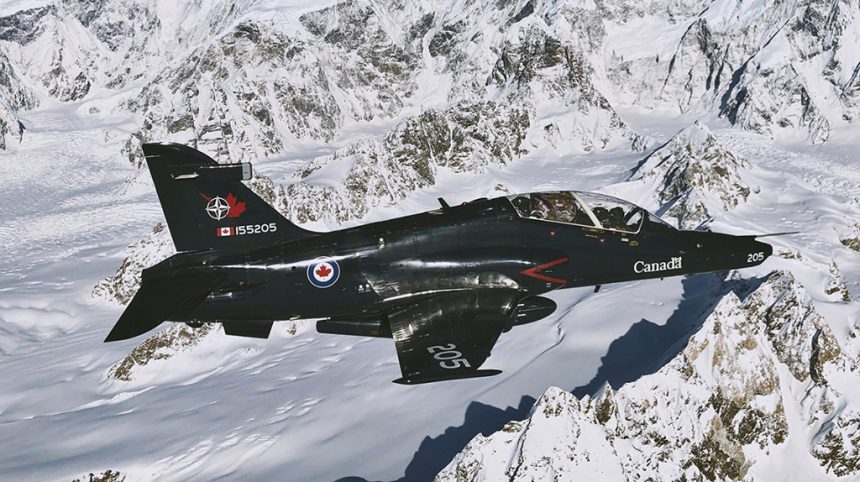Royal Canadian Air Force announced that it will retire its CT-155 fleet and go on a period of hiatus for its pilot training program.
On March 8, 2024, the Royal Canadian Air Force (RCAF) announced that it will officially be retiring its fleet of CT-155 Hawk advanced trainer aircraft. 419 Tactical Fighter Training Squadron (419e Escadron d’entraînement à l’appui tactique), in charge of training the RCAF’s fixed wing fighter pilots, have held a cessation of operation ceremony last Friday in Cold Lake, Alberta. The occasion also marked the beginning of a period of hiatus for the RCAF’s fixed wing training ops. This decision stems from the air force’s decision to transition its current CF-18 fleet to the F-35A. As of now it is yet unknown how long the RCAF will cease its flight training ops for.
On Friday, 419 Tactical Fighter Training Squadron held a cessation of operations ceremony in Cold Lake, Alta to both mark the end of CT-155 Hawk training operations for the #RCAF and to begin a period of hiatus. pic.twitter.com/mib7vfWEid
— Royal Canadian Air Force (@RCAF_ARC) March 10, 2024
CT-155 Hawk ends its 24-year service with the RCAF
The decision to phase out the aging CT-155 fleet has been long forthcoming. With the RCAF’s contract with CAE for training its pilots on the CT-155 ending this year and the decision to acquire F-35s approved, the time to overhaul the Hawks have finally come. The CT-155 Hawks, originally built to the Hawk 115 standard, is based on a 30 plus year old design at heart, despite its upgrades. A total of 22 aircraft were initially delivered to the RCAF, mainly flying with 419 squadron and a handful with 2 Canadian Forces Flying Training School (CFFTS / 2e École de pilotage des Forces canadiennes)
For the last 24 years the CT-155 Hawk has served with the RCAF as their main advanced trainer aircraft, serving as the last step before student pilots moved onto the CF-18 Hornets. A typical training course for a fixed wing fighter would go through four training phases, of which Phase III and IV would be on the CT-155. Student pilots would spend a total of 80 flying hours in the CT-155 initially at CFFTS during Phase III training on before moving onto 419 TFTS for Phase IV. During Phase III training the fast-jet candidates train on basic manoeuvres, which upon completion are awarded their Pilot’s Wings. Phase IV involves 48.9 flying hours of basic fighter training in preparation for their roles on the CF-18. Despite the airframe’s outdated origins, the CT-155 was fitted with a modern glass cockpit with multifunction displays and Heads-Up Display that uses symbology similar to that on the CF-18, along with basic avionics such as Hands On Throttle And Stick (HOTAS) for preparation on flying 4th generation fighter aircraft.
However, with the RCAF’s decision to replace the aging CF-18 fleet with the F-35A, the need for a new training jet to prepare for the 5th generation fighter has become apparent. Especially with the Canadian government’s deal to buy 88 F-35As being announced on Jan. 9, 2023, the Hawk fleet have started to become outdated. While the RCAF is in search for a suitable training aircraft, the national fast jet training program has been put on hold.
RCAF to turn to NATO partners for pilot training in the meantime
During its period of hiatus, the RCAF will partner with its allies to train their future fighter pilots. One of the first steps of this interim solution is mainly through the Euro-NATO Joint Jet Pilot Training (ENJJPT) program based at Sheppard Air Base, Texas. Future RCAF pilots will also be diverted to other NATO countries with similar programs such as the Fighter Lead-in Training (FLT) in Finland and the International Flight Training School in Italy. Officials have noted that there will be two instructors and six students in Italy by 2025. The ENJJPT in the US offers the USAF’s updated T-38, which the RCAF have been part of since the program’s beginning in 1981. From now there will be up to seven students sent to the US under the scheme. Finland, another country that operates the F/A-18, will be able to offer the RCAF students another variant of the Bae Hawk as part of their program. Most notably, IFTS in Italy is also currently training RAF students due to the ongoing issues with their training pipeline back home. Currently the IFTS offers a training course based on the T-346. The T-346 can provide adequate training for 5th generation aircraft with most equipment that can be found on modern frontline fighter aircraft such as Voice Control Inputs (VCI), Helmet Mounted Display (HMD), and even an NVG module for the HMD allowing for night operations training.
According to LCol Kean on the day, while the squadron is on hiatus from operations its personnel will support other units at 4 Wing Cold Lake, awaiting the planned reactivation of the squadron in the early 2030s. Until then, the squadron will remain administratively active, so that it can resume its role as the RCAF’s Tactical Fighter Training Squadron. On the other hand, the CT-155 Hawks will eventually move to the Canadian Forces School of Aerospace Technology and Engineering at Canadian Forces Base Borden, Ontario, where they will support the training of RCAF aircraft technicians.
While no official program has set to replace the CT-155, it appears that Boeing is already making its move to pitch its T-7A Red Hawk as the next generation fighter training aircraft to the RCAF. Developed in conjunction with Saab, the T-7A won the USAF’s T-X program in 2018 to replace the T-38 fleet. Former general officer Charles Sullivan has been on record that “I would love to see the Snowbirds fly the T-7.” With the T-7A being the newest of the current generation advanced trainer aircraft, it should be carefully noted if the program would secure its first export customer in the coming years.









